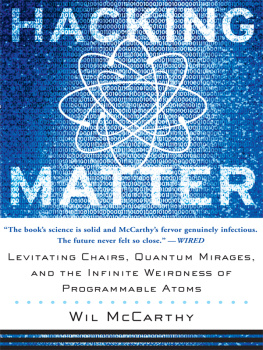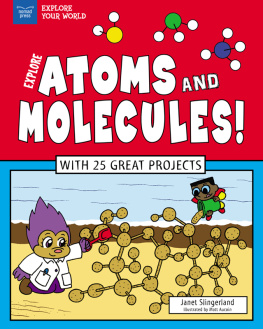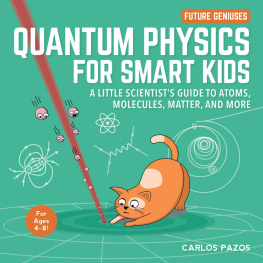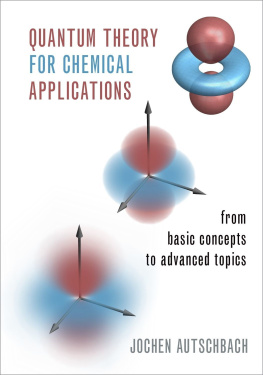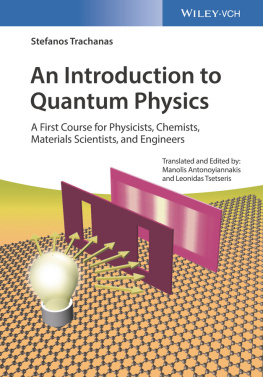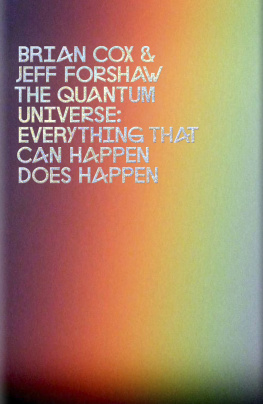McCarthy - Hacking matter: levitating chairs, quantum mirages, and the infinite weirdness of programmable atoms
Here you can read online McCarthy - Hacking matter: levitating chairs, quantum mirages, and the infinite weirdness of programmable atoms full text of the book (entire story) in english for free. Download pdf and epub, get meaning, cover and reviews about this ebook. City: New York, year: 2004;2011, publisher: Basic Books, genre: Romance novel. Description of the work, (preface) as well as reviews are available. Best literature library LitArk.com created for fans of good reading and offers a wide selection of genres:
Romance novel
Science fiction
Adventure
Detective
Science
History
Home and family
Prose
Art
Politics
Computer
Non-fiction
Religion
Business
Children
Humor
Choose a favorite category and find really read worthwhile books. Enjoy immersion in the world of imagination, feel the emotions of the characters or learn something new for yourself, make an fascinating discovery.
- Book:Hacking matter: levitating chairs, quantum mirages, and the infinite weirdness of programmable atoms
- Author:
- Publisher:Basic Books
- Genre:
- Year:2004;2011
- City:New York
- Rating:4 / 5
- Favourites:Add to favourites
- Your mark:
- 80
- 1
- 2
- 3
- 4
- 5
Hacking matter: levitating chairs, quantum mirages, and the infinite weirdness of programmable atoms: summary, description and annotation
We offer to read an annotation, description, summary or preface (depends on what the author of the book "Hacking matter: levitating chairs, quantum mirages, and the infinite weirdness of programmable atoms" wrote himself). If you haven't found the necessary information about the book — write in the comments, we will try to find it.
Hacking matter: levitating chairs, quantum mirages, and the infinite weirdness of programmable atoms — read online for free the complete book (whole text) full work
Below is the text of the book, divided by pages. System saving the place of the last page read, allows you to conveniently read the book "Hacking matter: levitating chairs, quantum mirages, and the infinite weirdness of programmable atoms" online for free, without having to search again every time where you left off. Put a bookmark, and you can go to the page where you finished reading at any time.
Font size:
Interval:
Bookmark:
Also by Wil McCarthy
The Wellstone
The Collapsium
Bloom
Murder in the Solid State
The Fall of Sirius
Flies from the Amber
Aggressor Six
and the Infinite Weirdness of
PROGRAMMABLE ATOMS

This books prologue first appeared, in slightly different form, as an essay in NATURE. Other chapters are derived in part from material first published in WIRED, Analog, Science Fiction Weekly, Science Fiction Age, and assorted other magazines and Internet sites.
Copyright 2003 by Wil McCarthy
Published by Basic Books,
A Member of the Perseus Books Group
Hardback first published in 2003 by Basic Books
Paperback first published in 2004 by Basic Books
All rights reserved. Printed in the United States of America. No part of this book may be reproduced in any manner whatsoever without written permission except in the case of brief quotations embodied in critical articles and reviews. For information, address Basic Books, 387 Park Avenue South, New York, NY 10016-8810.
Books published by Basic Books are available at special discounts for bulk purchases in the United States by corporations, institutions, and other organizations. For more information, please contact the Special Markets Department at the Perseus Books Group, 11 Cambridge Center, Cambridge MA 02142, or call (617) 2525298, (800) 2551514 or
e-mail
Designed by Jeff Williams
Set in 10.5-point Garamond MT by the Perseus Books Group
Library of Congress Cataloging-in-Publication Data
McCarthy, Wil.
Hacking matter : levitating chairs, quantum mirages, and the infinite
weirdness of programmable atoms / Wil McCarthy.
p. cm
Includes index.
ISBN-13 978-0-465-04428-3 (hc)
ISBN-13 978-0-465-04429-0 (pbk)
ISBN-10 0-465-04428-X (hc)
ISBN-10 0-465-04429-8 (pbk)
eBook ISBN: 9780786723416
1. NanotechnologyForecasting. 2. Quantum electronicsForecasting.
I. Title.
T174.7 .M38 2002
620.50112--dc21
2002015887
To Michael and Evalyn McCarthy,
for making me curious
Were always looking for new physics;
new behavior that has never been seen
before. Once we find it, of course, we
start to daydream.
MARC KASTNER
PROGRAMMABLE MATTER: A RETROSPECTIVE
THE FLICK OF A SWITCH: a wall becomes a window becomes a hologram generator. Any chair becomes a hypercomputer, any rooftop a power or waste treatment plant. We scarcely notice; programmable matter pervades our homes, our workplaces, our vehicles and environments. There isnt a city on Earthor Mars, for that matterthat isnt clothed in the stuff from head to toe. But though we rarely stop to consider it, the bones of these citiestheir streets, their sewers, the hearts of their telecom networkswere laid out during a time when the properties of matter were dictated exclusively by Mother Nature.
Just imagine: if specific mechanical or electrical properties were desired, one first had to hire miners to extract appropriate elements from the Earth, then chemists and metallurgists to mix precise proportions under precise conditions, then artisans to craft the resulting materials into components, and assemble the components into products that could then be transported to the location of desired use. The inconvenience must have been staggering.
In the twenty-second century, of course, any competent designer will simply define the shape and properties she requiresincluding unnatural traits like superreflectance, refraction matching (invisibility), and electromagnetically reinforced atomic bondsand then distribute the configuration file to any interested users. But prior to the invention of wellstone the earliest form of programmable matterthis would have sounded like pure fantasy. With that in mind, well look back on the invention upon which, arguably, our entire modern civilization rests.
Consider silicon, whose oxide is the primary component of rockliterally the commonest material on Earth. Humans had been making hammers and axes and millstones out of it for millions of years, but as it happens, silicon is also a semiconductora material capable of conducting electrons only within a narrow energy band.
While silicon was invaluable in the development of twentieth-century digital electronics, its killer app eventually proved to be as a storage medium for electrons. When layered in particular ways, doped silica can trap conduction electrons in a membrane so thin that, from one face to the other, their behavior as tiny quantum wave packets takes precedence over their behavior as particles. This structure is called a quantum well. From there, confining the electrons along a second dimension produces a quantum wire, and finally, with three dimensions, a quantum dot.
The unique trait of a quantum dot, as opposed to any other electronic component, is that the electrons trapped in it will arrange themselves as though they were part of an atom, even though theres no atomic nucleus for them to surround. Which atom they emulate depends on the number of electrons and the exact geometry of the wells that confine them, and in fact where a normal atom is spherical, such designer atoms can be fashioned into cubes or tetrahedrons or any other shape, and filled with vastly more electrons than any real nucleus could support, to produce atoms with properties that simply dont occur in nature.
Significantly, the quantum dots neednt be part of the physical structure of the semiconductor; they can be maintained just beneath the surface through a careful balancing of electrical charges. In fact, this is the preferred method, since it permits the dots characteristics to be adjusted without any physical modification of the substrate.
Who invented wellstone remains a matter of confusion and debate; similar work was being performed in parallel, in laboratories all over the world. But regardless of where the idea originated, the concept itself is deceptively simple: a lattice of crystalline silicon, superfine threads much thinner than a human hair, crisscrossing to form a translucent structure with roughly the density of polyethylene. Wellstone behaves fundamentally as a semiconductor, except that with the application of electrical currents, its structure can be filled with atoms of any desired species, producing a virtual substance with the mass of diffuse silicon, but with the chemical, physical, and electrical properties of some new, hybrid material.
Wellstone iron, for example, is weaker than its natural counterpart, less conductive and ferromagnetic, basically less iron-like, and if you bash it over and over with a golf club it will gradually lose any resemblance to iron, reverting instead to shattered silicon and empty space. On the other hand, its feather-light, wholly rustproof, and changeable at the flick of a bit into zinc, rubidium, or even otherwise-impossible substances like impervium, the toughest superreflector known.
Of the changes wrought by programmable matter in the past one hundred years, not all have been universally welcomed. In the grand Promethean tradition, wellstone places the power of creation and destruction squarely in human hands. Many have argued that far from making us strong, this power fosters a quiet corruption of spirit. Still, the fable of the three little pigs holds true: not even the Luddites among us build their houses of straw or sticks when impervium is a free download.
Font size:
Interval:
Bookmark:
Similar books «Hacking matter: levitating chairs, quantum mirages, and the infinite weirdness of programmable atoms»
Look at similar books to Hacking matter: levitating chairs, quantum mirages, and the infinite weirdness of programmable atoms. We have selected literature similar in name and meaning in the hope of providing readers with more options to find new, interesting, not yet read works.
Discussion, reviews of the book Hacking matter: levitating chairs, quantum mirages, and the infinite weirdness of programmable atoms and just readers' own opinions. Leave your comments, write what you think about the work, its meaning or the main characters. Specify what exactly you liked and what you didn't like, and why you think so.

